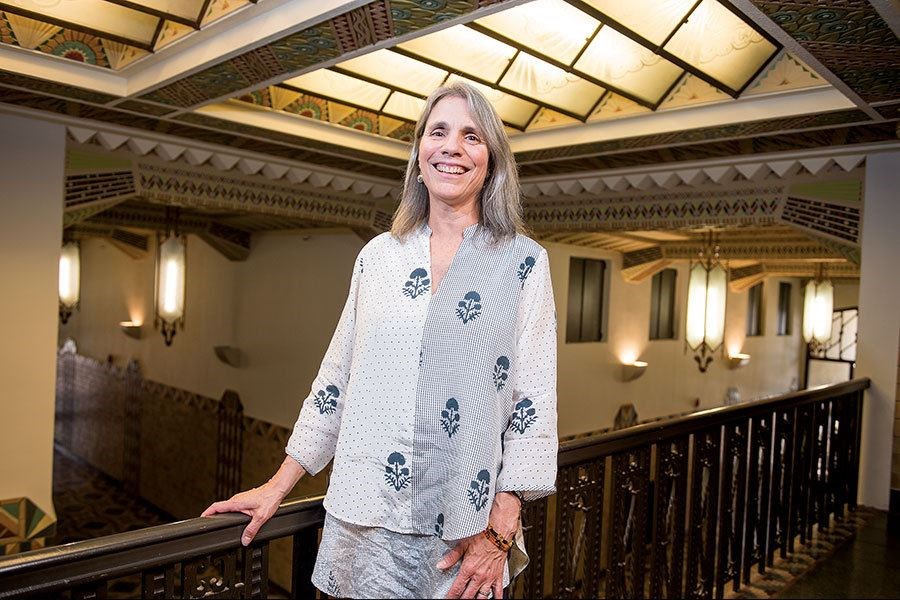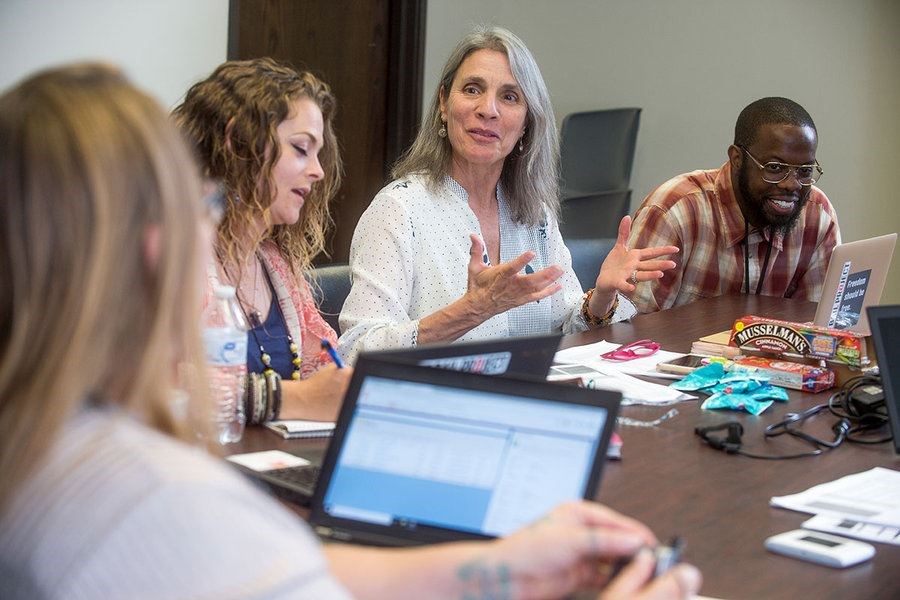Reprinted with permission from The Christian Science Monitor
Too frequently, bail doesn't work the way it was intended. Robin Steinberg has launched an initiative that is drawing attention to this often-overlooked issue, with a plan to bail out 160,000 people in the US.
July 25, 2018 - TULSA, OKLA. - It was over a late-night Chinese meal in New York with her then colleague, now husband, that Robin Steinberg first hit on the idea for a bail fund.
 Last year Robin Steinberg launches The Bail Project, a five-year plan to bail out 160,000 people in more than 40 US locations.Anne Hermes/StaffMs. Steinberg and David Feige were both public defenders in the Bronx, a borough of New York, where they saw every day how cash bail hampered clients who couldn’t afford to pay to get out of detention.
Last year Robin Steinberg launches The Bail Project, a five-year plan to bail out 160,000 people in more than 40 US locations.Anne Hermes/StaffMs. Steinberg and David Feige were both public defenders in the Bronx, a borough of New York, where they saw every day how cash bail hampered clients who couldn’t afford to pay to get out of detention.
“We were venting about some client who had just pled guilty [to avoid being stuck in jail] and how frustrating it was and how outrageous it was. And he said, ‘You should just start a bail fund and start bailing people out of jail,’ ” Steinberg says.
Bail was instituted as a way to ensure that a defendant returns to court – to retrieve the money he or she posted. But too often it hasn’t worked that way. So in 2007, Steinberg launched the Bronx Freedom Fund, a revolving nonprofit fund for poor people being held in jail before trial.
By bailing them out for $768 on average, Steinberg was able to work on their cases while they went back to their homes and families and jobs. And her team made sure that clients showed up for court dates. Once their cases are heard and judged, the bond money returns to the fund, with each dollar circulating more than twice a year.
What Steinberg found was that freedom made all the difference.
 Robin Steinberg (c.), chief executive officer of The Bail Project, talks with members of her team in Tulsa, Okla.: Richard Baxter (r.), Shawna Harrell (l.), and Michelle Murphy, (l.).Ann Hermes/StaffMore than half of the cases resulted in all charges being dismissed, while others ended in noncustodial sentences. Only 2 percent of clients were sentenced to jail for the original charges.
Robin Steinberg (c.), chief executive officer of The Bail Project, talks with members of her team in Tulsa, Okla.: Richard Baxter (r.), Shawna Harrell (l.), and Michelle Murphy, (l.).Ann Hermes/StaffMore than half of the cases resulted in all charges being dismissed, while others ended in noncustodial sentences. Only 2 percent of clients were sentenced to jail for the original charges.
She wondered, why stop in the Bronx? Although other community bond funds had popped up and lawmakers in New Jersey and Maryland had capped the use of cash-based bail, the scale of pretrial incarceration across the United States has remained immense. On an average night, 450,000 people are in local jails awaiting trial. Most are too poor to pay bail.
Last November, Steinberg launched The Bail Project, a five-year, $52 million plan to bail out 160,000 people in more than 40 locations, starting with New York City. It has since set up funds in Tulsa, Okla.; St. Louis; Detroit; and Louisville, Ky., hiring local “bail disrupters” to track and assist low-income defendants.
The initiative is one of five chosen this year as a TED Audacious Project, which pools money from philanthropists for “big bets” on ideas with broad social effect. The Bail Project will receive $24 million over five years, while Steinberg continues to raise money to expand its reach, says Anna Verghese, who runs the Audacious Project.
“There was something game-changing about this idea,” she says. It was also a reflection on Steinberg’s determination to deliver. “She’s extremely loyal and extremely committed to this work. She’s resilient.”
“Impatience is probably what drives me most,” says Steinberg, who talks with expansive hand gestures and empathetic nods. “Nothing’s ever happening quickly enough.”
Steinberg takes a worm’s-eye view of social issues that puts her legal clients first, says Mr. Feige, who helped her set up the Bronx Defenders, a nonprofit law firm, in 1997. “Her profound belief is that answers to vexing criminal justice problems can be best assessed from the ground up,” he says.
Indeed, each jurisdiction has its own set of factors. In Tulsa, Steinberg opened Still She Rises in 2017 with support from a local philanthropist. It’s a legal-aid firm for low-income mothers – the first of its kind – and is in a state that locks up the most women per capita. Similarly, The Bail Project in Tulsa focuses on mothers held in pretrial detention, including those at risk of losing custody of their children the longer they stay behind bars.
“I went to [law] school thinking I wanted to be a legal defender for women, then spent most of my career defending men,” she says.
Law school wasn’t a given for Steinberg, who was a politically active teen and middling student in New York. During her senior year of high school, her mother remarried and moved her, unwillingly, to California. Prodded by her stepfather to go to college, she enrolled at the University of California, Berkeley and found her tribe. In 1978 she was the first to graduate from its women’s studies program.
She moved back to New York and went to law school. As a public defender, she was drawn to the South Bronx, one of the country’s most deprived districts.
The Bronx Defenders now has 300 lawyers who represent more than 30,000 people a year. Steinberg stepped down last December as its executive director so she could run The Bail Project from her new position as a senior fellow at the UCLA School of Law.
On a recent afternoon, Steinberg wraps up a lunch with new interns at Still She Rises, a brightly lit office located in a run-down mall in North Tulsa, a predominantly black neighborhood where most of the firm’s clients live. Outside the office, she gets into her 2004 Volvo station wagon with its bumper sticker – Well Behaved Women Rarely Make History – and heads downtown.
Tulsa’s bail disrupters are two blocks from the courthouse in an Art Deco office building that’s a reminder of the city’s 1920s oil wealth. Upstairs, Steinberg’s technology director is coaching the team – two women and one man, each with a personal story of incarceration and injustice – on how to use mobile apps to track bail recipients. On the table are juice boxes and snacks for recipients who have just been bailed out.
Steinberg wants to test her belief that bail is both unjust and ineffective. Most poor people aren’t flight risks; they miss court dates because they don’t have subway fare or a fixed address, legal advocates say. That’s why disrupters get contact details for the friends and family members of defendants and make sure they have a ride to court.
In the Bronx, Steinberg found that money isn’t what makes people come back, and that inspires her hope that bail reform is possible in Tulsa and other cities. “The work here is going to inform people that you don’t need all those systems,” she says.
Shawna Robinson, one of the disrupters, nods admiringly. “They have never gone up against a strategic intelligent workhorse like Robin in this town, ever.”
“Oh, nonsense,” Steinberg says. “There are a lot of strategically brilliant people in this town, including you three around this table.”
Everyone begins talking, but the loudest voice belongs to Richard Baxter. “Hang on! But one thing is being unafraid.” He pauses to look at Steinberg. “See, she didn’t say nothing; no rebuttal there. She’s not afraid.”
More than 100 women have been bailed out in Tulsa since January. One is Cynthia Reed, a middle-aged homeless woman from Texas arrested in May after she took a folder from a dumpster that allegedly contained a police document. Four days later, Mr. Baxter paid $3,000 to the court. “I thought nobody was going to bail me out. Nobody knows me here,” she says.
Baxter has since helped her find a homeless shelter and get food stamps and a cellphone. Ms. Reed, her face and shoulders brown from the summer sun, drops by the office to meet with Baxter. She’s upbeat about beating the charges at her court hearing. “I’m not going to cop to it,” she says.
Steinberg has a dinner with a donor, so she packs into the elevator with her team and Reed, who’s headed to her shelter. She smiles as Baxter chats about next steps. Steinberg turns to Reed and says, “You have the most beautiful face.”
Page created on 7/27/2018 5:40:11 AM
Last edited 7/27/2018 5:52:30 AM
